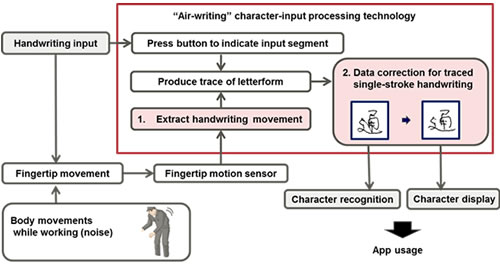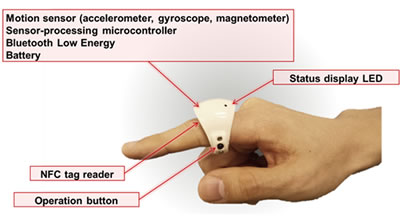Archived content
NOTE: this is an archived page and the content is likely to be out of date.
Fujitsu Laboratories Develops Ring-Type Wearable Device Capable of Text Input by Fingertip
Weighing under 10 grams, this compact and light device enables efficient hands-free operations
Fujitsu Laboratories Ltd.
Kawasaki, Japan, January 13, 2015
Fujitsu Laboratories Ltd. today announced the development of a compact and lightweight wearable ring-type device that offers handwriting-input functionality and a reader for near-field communications (NFC) tags.
Wearable devices have been making inroads into the workplace in recent years, notably with head-mounted displays (HMDs), in line with putting ICT to use so as to not stop what they are doing. But HMDs do not make it easy to select displayed information such as "yes" or "no," to input figures, make notes on workplace conditions, or perform other necessary actions.
The ring-type wearable device that Fujitsu Laboratories developed identifies the fingertip movements users make as they write in the air, and recognizes that tracing as a letterform. By writing in the air with one's fingertip, operators can select menu options or make memos on photos that they take in the field. By applying proprietary technology that corrects the letterform tracings, Fujitsu Laboratories has been able to improve character recognition accuracy, enabling recognition of everything from numbers to Chinese characters. Furthermore, with a built-in NFC tag reader, operators can specify an object to be worked on with a touch on its NFC tag and display an operation's details. As data from the object to be worked on can be easily selected in a hands-free manner, the performance of maintenance and other tasks is expected to be more efficient.
Background
With modern advances in the miniaturization of smart devices, communications technology, and cloud environments, there is interest in using HMDs and other wearable devices for maintenance and other tasks in factories and buildings where ICT can be put to use to free up hands for operations. Because operators do not need to hold devices in their hands to receive information in the field, there are especially high expectations for the use of such wearable devices in fieldwork for which operators need use of their hands at all times.
Issues
With display devices such as HMDs, it is possible to browse information without taking out a separate smart device. Users can therefore receive information without occupying their hands. The problem, however, is that it is difficult to manipulate the information received. Entering numbers or taking notes has required either a separate device or a notepad, forcing the operator to interrupt the task at hand.
About the Technology
Fujitsu Laboratories has developed a lightweight and compact device wearable as a ring that makes it easy to draw letterforms in the air as a way to select displayed content and take notes. Despite being ring-sized, the device includes motion sensors for text input, an NFC tag reader, and wireless communication functionality.
Key features of the technology are as follows.
- "Air-writing": text entry by writing in the air
Fujitsu Laboratories developed handwritten character input and recognition technology that uses motion sensors built into the ring to trace the movements of the operator's finger. As the operator writes in the air, the technology uses that information to extract the motion components for input and character recognition. For numeric entry, which is widely used in the field, recognition accuracy has reached approximately 95% even without any special training.
In order to recognize "air-writing", the technology needs to be able to distinguish between the finger strokes that make up the letterform and the empty spaces that the finger moves through between the strokes. Using a button to indicate "pen down" and "pen up" states would be troublesome, so Fujitsu Laboratories took an approach that allows for longhand writing in a fluid single-stroke motion. Recognition accuracy is usually poorer for single-stroke characters when compared with handwriting using a pen or touchscreen. Furthermore, if one wants to store the trace of the longhand handwriting as-is for a memo, without attempting to perform recognition on it, the single-stroke character can be difficult to read since the parts of letters are all connected. What Fujitsu Laboratories has done is to develop a technology that automatically recognizes the unwanted connections between the strokes of the letterform that result from the longhand trace, and correct the track data accordingly (Figure 1). This correction improves letterform legibility and text recognition rates.
 Figure 1: Air handwriting and stroke compensation technologies
Figure 1: Air handwriting and stroke compensation technologies
- Compact and lightweight
Fujitsu Laboratories previously developed a glove-style wearable device(1) that can be used to indicate work processes or enter results using natural actions, such as touching an object or performing a motion gesture. While incorporating certain aspects of the previous glove-style device, the new ring device compresses the ability to perform a variety of input operations into a device weighing less than 10 grams that is worn on a finger. Like the previous glove-type device, it includes an NFC reader that detects when a finger touches an NFC tag, as well as the same motion sensors (accelerometer, gyroscope, magnetic sensor). Each component has been optimally laid out to minimize the size of the device, and power-saving technology enables the usage of a button cell battery, which also contributes to the miniaturization of the device. To begin air-writing, the operator uses their thumb to press an operation button, which makes it easy to operate using just one hand without operation errors (Figure 2).
 Figure 2: The ring-type wearable device
Figure 2: The ring-type wearable device
Results
The ring-type wearable device can be used to enter numbers and take notes using handwriting in the air. In addition, an NFC tag reader enables the operator to tap on a tagged object to display the appropriate information on a relevant operation's details or instructions. This technology allows operators to manipulate data without stopping what they are doing and with a minimum of movement, even while holding other tools.
Future Plans
Fujitsu Laboratories is testing the real-world usability of the device in the field with a goal of practical implementation during fiscal 2015. In addition, by applying the underlying technologies to a variety of usage scenarios, Fujitsu seeks to leverage the power of ICT to hasten the emergence of a Human Centric Intelligent Society that generates creative innovations.
About Fujitsu
Fujitsu is the leading Japanese information and communication technology (ICT) company offering a full range of technology products, solutions and services. Approximately 162,000 Fujitsu people support customers in more than 100 countries. We use our experience and the power of ICT to shape the future of society with our customers. Fujitsu Limited (TSE: 6702) reported consolidated revenues of 4.8 trillion yen (US$46 billion) for the fiscal year ended March 31, 2014. For more information, please see http://www.fujitsu.com.
About Fujitsu Laboratories
Founded in 1968 as a wholly owned subsidiary of Fujitsu Limited, Fujitsu Laboratories Ltd. is one of the premier research centers in the world. With a global network of laboratories in Japan, China, the United States and Europe, the organization conducts a wide range of basic and applied research in the areas of Next-generation Services, Computer Servers, Networks, Electronic Devices and Advanced Materials. For more information, please see: http://www.fujitsu.com/jp/group/labs/en/.
Press Contacts
Public and Investor Relations Division
Inquiries
Company:Fujitsu Limited
Technical Contacts
Human Centric Computing Laboratories
Human Interaction Lab
 E-mail: wearable@ml.labs.fujitsu.com
E-mail: wearable@ml.labs.fujitsu.com
Company:Fujitsu Laboratories Ltd.
All company or product names mentioned herein are trademarks or registered trademarks of their respective owners. Information provided in this press release is accurate at time of publication and is subject to change without advance notice.
Date: 13 January, 2015
City: Kawasaki, Japan
Company:
Fujitsu Laboratories Ltd.
![]() E-mail: wearable@ml.labs.fujitsu.com
E-mail: wearable@ml.labs.fujitsu.com
